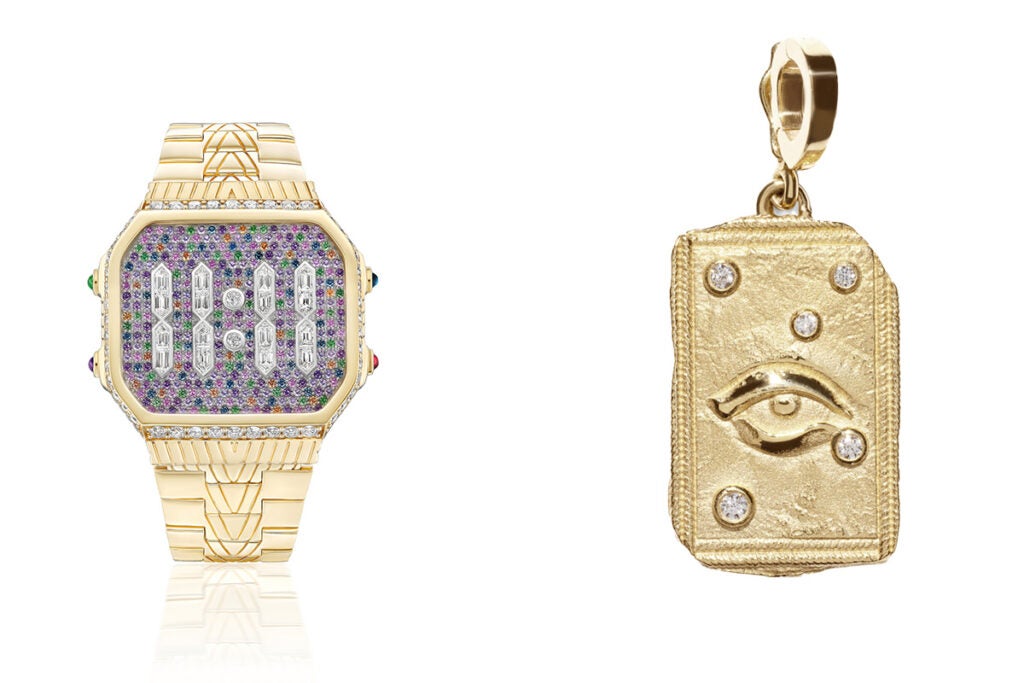
When Ananya Malhotra visited her grandparents in southern India as a child, they’d discuss the importance of Karma, the meaning of life and the dharmic cycle. For a deeply spiritual family, the healing properties of gemstones were embedded in everyday life; their astrologer would recommend different varieties for health, protection and prosperity. Yet traditional Indian jewellery didn’t appeal to Malhotra, who spent her twenties between Chennai, Miami and London, where she studied jewellery design at Central Saint Martins.
[See also: The Spear’s Power List 2024: Who made the cut?]
When her healer advised she wear ruby beads to unlock her root chakra, she strung them around her wrist, fastened with an angular gold bar. The Chakra bracelet is now a bestseller for her brand, Ananya. Stocked at Net-a-Porter and the Webster in New York, it can just as easily be styled alongside a Cartier Love bangle and jeans as a lehenga. It’s worn by women of all backgrounds, regardless of their familiarity with the Indian concept of ‘navaratna’ on which it is based.

Malhotra now holds events in which a healer guides clients of all cultures towards the gemstones and mantras that might help them achieve inner balance. ‘We live in a world where there is so much unknown and uncertainty; people look for tools or amulets to give them strength and encouragement,’ she says. Her bracelets’ popularity reflects an ever-growing appetite for spirituality in jewellery at every level.
[See also: One of a kind: Inside McLaren’s ultra-exclusive world of bespoke supercars]
Beth Hanaway, director of buying for fine jewellery and watches at Harrods, says: ‘Customers are requesting designs that embody their unique spiritual journeys and emotional connections.’ She names LA designer Azlee and Beirut-based L’Atelier Nawbar as two brands whose spiritual influences have garnered commercial success. Azlee’s 18kt gold medallions feature symbols taken from Greek and Roman mythology associated with qualities such as peace, strength, power or renewal, while L’Atelier Nawbar translates ancient Eastern protective motifs such as the Evil Eye and Hand of Hamsa into colourful fine jewellery with broad cultural appeal.

‘Humans first wore jewellery for talismanic reasons. In a way, jewellery has always been used as a visual and tangible form of spirituality – whether that was for protection against the unknown, malevolent forces or as a guide to an afterlife,’ says Carol Woolton, author of If Jewels Could Talk, which explores the history and meaning behind universal designs and motifs.
She lists the ancient Egyptian Ankh, a symbol of eternity and knowledge; the scarab beetle, which began as a funerary charm for a prosperous afterlife; and the Evil Eye motif, a protector against envious glances, as three such symbols, all of which are scattered across the contemporary jewellery landscape. ‘Magical thinking has a robust role in human life. We may have different preoccupations from our ancestors, but when faced with challenges that seem insurmountable anything can seem worth a go,’ she says.
Elsewhere, designers are exploring arcane mysticism and spirituality; themes that can border on the woo-woo. San Francisco-based Harwell Godfrey’s Supernova collection was created to celebrate ‘the abundance and magic of the universe’, says founder Lauren Harwell Godfrey. It includes kaleidoscopic, gemstone-strewn designs linked to superstitions such as throwing salt over one’s shoulder for luck, and the magic of a watch stopped at 11:11.

For her brand Tabayer, designer Nigora Tokhtabayeva sought stories and symbols that transcend religious and cultural boundaries. She honed in on the knot of reeds woven by Inanna, the Mesopotamian goddess of love, war and fertility. ‘I was captivated by what she represented – these contrasting elements of vulnerability and strength,’ she says. The resulting Oera collection features sculptural gold and hardstone bangles, rings and earrings, whose contemporary, pared-back aesthetic belies the age-old spirituality behind their design.
[See also: Strike gold with the new raft of bracelet watches]
London-based designer Satta Matturi is inspired by the ancient power of Nomoli masks, believed to be the earliest form of West African art. The stone figurines were kept in homesteads and consulted as oracles; Matturi’s bejewelled odes to the artefacts draw on their symbolism as bearers of protection and good luck.

‘Traditional West African jewellery is not just ornamental but considered to be imbued with spiritual powers through the materials used,’ she says, referring to the gold worn by Akan nobility, as well as beads and cowrie shells adorned for protection across the region.
The importance of spirituality has not escaped larger houses. Dior’s Rose des Vents fine jewellery line is based on the ‘wind rose’, an eight-pointed star that served as Christian Dior’s lucky talisman. Chanel Fine Jewellery riffs on symbols dear to its superstitious founder, such as stars, lions and the number five. Bulgari’s iconic Serpenti snake symbolises rebirth; Van Cleef & Arpels’ best-selling Alhambra range is an instantly recognisable four-leaf clover. Dolce & Gabbana’s extravagant Alta Gioielleria creations incorporate iconography linked to its Italian roots, including crucifixes and cornicelli, the chilli pepper amulets hung in kitchens to ward off evil. The house’s latest collection celebrates the art of filigree, with gold wire woven into intricate motifs taken from traditional Sardinian ceremonial bread.

This year, De Beers Jewellers’ high jewellery collection was dedicated to the spiritual significance of eight animals native to Botswana, one of its diamond-producing countries. ‘Animals have long been revered as symbols of spiritual energy, embodying qualities such as wisdom, intelligence, strength and grace. Our Forces of Nature collection was created to connect people with these powerful traits,’ says CEO Céline Assimon.
The one-of-a-kind designs include a set of interlocking rings to represent the spirituality of the greater kudu, whose spiralling horns are said to link earth and sky, as well as a voluminous choker that ripples with yellow diamonds and gold beads, an ode to the protective force of a lion. ‘People are drawn to animals on a spiritual level because they embody the pure, unfiltered forces of nature that we, as humans, sometimes lose touch with,’ says Assimon. ‘They also serve as powerful archetypes, representing qualities we admire or aspire to, such as courage, grace and wisdom. Through these connections, animals remind us of our intrinsic ties to the natural world and the virtues we seek to cultivate within ourselves.’
As Woolton says, ‘The gesture of putting on a spiritual motif each day can support the physiological feeling that you’ve taken action, which helps regain a sense of control in some small way.’






